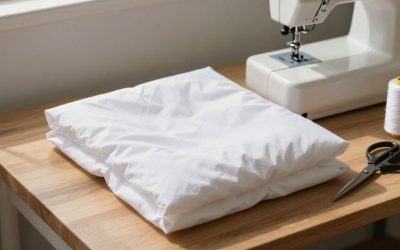When you’re looking for the perfect pillow, there are multiple factors to take into consideration. Understanding the ins and outs of the different types of material used in pillow materials can help you make an informed decision. Poplin fabric and microfiber fabric are two popular choices in pillows, but which one is the right fit for you? In this article, we will be comparing the two materials, discussing the pros and cons of each, as well as doing a cost and durability comparison.
What is Poplin Fabric?
Poplin fabric is a tightly woven and lightweight cotton-polyester fabric that is known for its versatility, strength and softness. Poplin fabric is often used in apparel manufacturing and home décor items, like pillow covers. Pima and Supima cotton varieties of poplin have a very high thread count, providing a smooth and comfortable finish.
Poplin fabric is a popular choice for dress shirts, blouses, skirts, and dresses. It is also used to make lightweight jackets and coats. Poplin fabric is often used to make bedding, curtains, and upholstery. It is also used to make lightweight bags and backpacks.
Poplin fabric is easy to care for and can be machine washed and dried. It is also resistant to wrinkles and can be ironed on a low setting. Poplin fabric is available in a variety of colors and prints, making it a great choice for a variety of projects.
What is Microfiber Fabric?
Microfiber fabric is made from synthetic materials, such as polyester and nylon, that are tightly woven together to create an ultra-fine fiber. Microfiber pillows are known for being lightweight and breathable, yet warm and cozy. They are also resistant to water and dust mites, making them ideal for those with allergies.
Microfiber fabric is also highly durable and can last for many years with proper care. It is also easy to clean and maintain, as it is resistant to stains and wrinkles. Additionally, microfiber fabric is often less expensive than other fabrics, making it a great choice for those on a budget.
Microfiber fabric is a great choice for a variety of uses, from bedding to upholstery. It is also a popular choice for clothing, as it is lightweight and comfortable. With its many benefits, it is no wonder that microfiber fabric is becoming increasingly popular.
Pros and Cons of Poplin Pillow
Pros: Poplin fabric pillows are a great option if you’re looking for a pillow that offers excellent breathability and moisture wicking, as well as a very comfortable finish. The material is also incredibly durable, so it won’t wear or tear easily. Additionally, the density of the fabric makes for minimal noise when you move your head or neck on the pillow.
Cons: Poplin pillows can be quite expensive as they are often made with high-quality fabrics. Additionally, the fabric may not be as breathable as some of its counterparts like microfiber.
Another con of poplin pillows is that they can be difficult to clean. The fabric is not machine washable, so you will need to spot clean it with a damp cloth and mild detergent. Additionally, the fabric may shrink if it is exposed to high temperatures, so it is important to be careful when drying the pillow.
Pros and Cons of Microfiber Pillow
Pros: Microfiber fabric pillows are typically more affordable than poplin pillows. The fabric is also known for its excellent breathability, making it a great alternative if you tend to heat up during the night. Additionally, microfiber pillows are hypoallergenic, making them perfect for allergy sufferers.
Cons: Although microfiber pillows can be comfortable, they tend to be not as durable as poplin pillows. The fabric can sometimes have a stiff feel to it, which some may find uncomfortable. Additionally, microfiber pillows can be quite noisy when you move your head or neck on them.
Another con of microfiber pillows is that they can be difficult to clean. The fabric is not as easy to spot clean as other materials, and it can be difficult to get the pillow completely dry after washing. Additionally, the fabric can be prone to pilling, which can make the pillow look worn and unattractive.
Overall, microfiber pillows can be a great option for those looking for an affordable and breathable pillow. However, it is important to consider the pros and cons before making a purchase, as the fabric may not be as durable or comfortable as other materials.
Cost Comparison of Poplin Pillow vs Microfiber Pillow
In terms of cost, poplin pillows are often more expensive than microfiber pillows. This is due to the high-quality materials used to manufacture poplin pillows. However, there can be some variation in prices depending on the quality and type of material used. In general, microfiber pillows tend to be more affordable than poplin pillows.
Poplin pillows are usually made from a blend of cotton and polyester, while microfiber pillows are usually made from a blend of polyester and nylon. The type of material used can affect the cost of the pillow, as well as the durability and comfort. Poplin pillows tend to be more durable and comfortable than microfiber pillows, but they may also be more expensive. Ultimately, it is important to consider the cost, quality, and comfort of the pillow when making a purchase.
Durability Comparison of Poplin Pillow vs Microfiber Pillow
Poplin pillows are known for their durability and are able to withstand multiple washings without shrinkage or fading. This makes them a great choice if you’re looking for a long-lasting pillow. On the other hand, microfiber fabric pillows may not be as long-lasting as poplin pillows, since the fabric is not as thick or tightly woven.
Poplin pillows are also more resistant to wear and tear than microfiber pillows, making them a better choice for those who are looking for a pillow that will last for years. Additionally, poplin pillows are more resistant to dust mites and other allergens, making them a great choice for those with allergies.
In terms of comfort, microfiber pillows are often softer and more comfortable than poplin pillows. They are also more lightweight and easier to transport, making them a great choice for those who travel frequently. However, microfiber pillows may not be as durable as poplin pillows, so they may need to be replaced more often.
Comfort Level Comparison of Poplin Pillow vs Microfiber Pillow
The comfort level of both types of pillows varies depending on the individual’s preference. Poplin material often offers a smoother and softer finish than microfiber material. On the other hand, microfiber pillows tend to be cooler to sleep on. Therefore, if you’re looking for a pillow that is soft and warm, then a poplin pillow may be the better choice.
Poplin pillows are also more durable than microfiber pillows, making them a great choice for those who want a pillow that will last for years. Additionally, poplin pillows are often more affordable than microfiber pillows, making them a great option for those on a budget.
When it comes to cleaning, microfiber pillows are generally easier to care for than poplin pillows. Microfiber pillows can usually be machine washed and dried, while poplin pillows should be spot cleaned or dry cleaned.
Maintenance & Care Instructions for Poplin Pillow and Microfiber Pillow
Both poplin and microfiber pillows can be machine washed and dried. However, it is important to read the care label in order to ensure that the pillow is washed at the right temperature. If possible, it is also recommended to line dry poplinpillows to prevent any shrinkage. Additionally, it is important to note that both materials should be kept away from direct sunlight in order to prevent fading.
When washing poplin pillows, it is important to use a mild detergent and avoid any fabric softeners or bleach. Additionally, it is important to avoid overloading the washing machine as this can cause the fabric to stretch and lose its shape. For microfiber pillows, it is important to use a gentle cycle and avoid any harsh detergents or fabric softeners. Additionally, it is important to avoid using any bleach or fabric softeners as this can damage the fabric.
When drying both poplin and microfiber pillows, it is important to use a low heat setting and avoid over-drying. Additionally, it is important to fluff the pillows regularly in order to maintain their shape and prevent any clumping. Finally, it is important to store the pillows in a cool, dry place in order to prevent any mold or mildew growth.
Final Verdict: Which is the Better Choice?
In conclusion, both poplin and microfiber pillows offer a variety of benefits for different kinds of sleepers. Poplin material tends to offer a softer and smoother finish than microfiber material. It is also long-lasting, making it ideal for those looking for an investment piece. On the other hand,microfiber material is cooler for sleepers and more affordable than poplin material. Ultimately, the decision comes down to personal preference.



